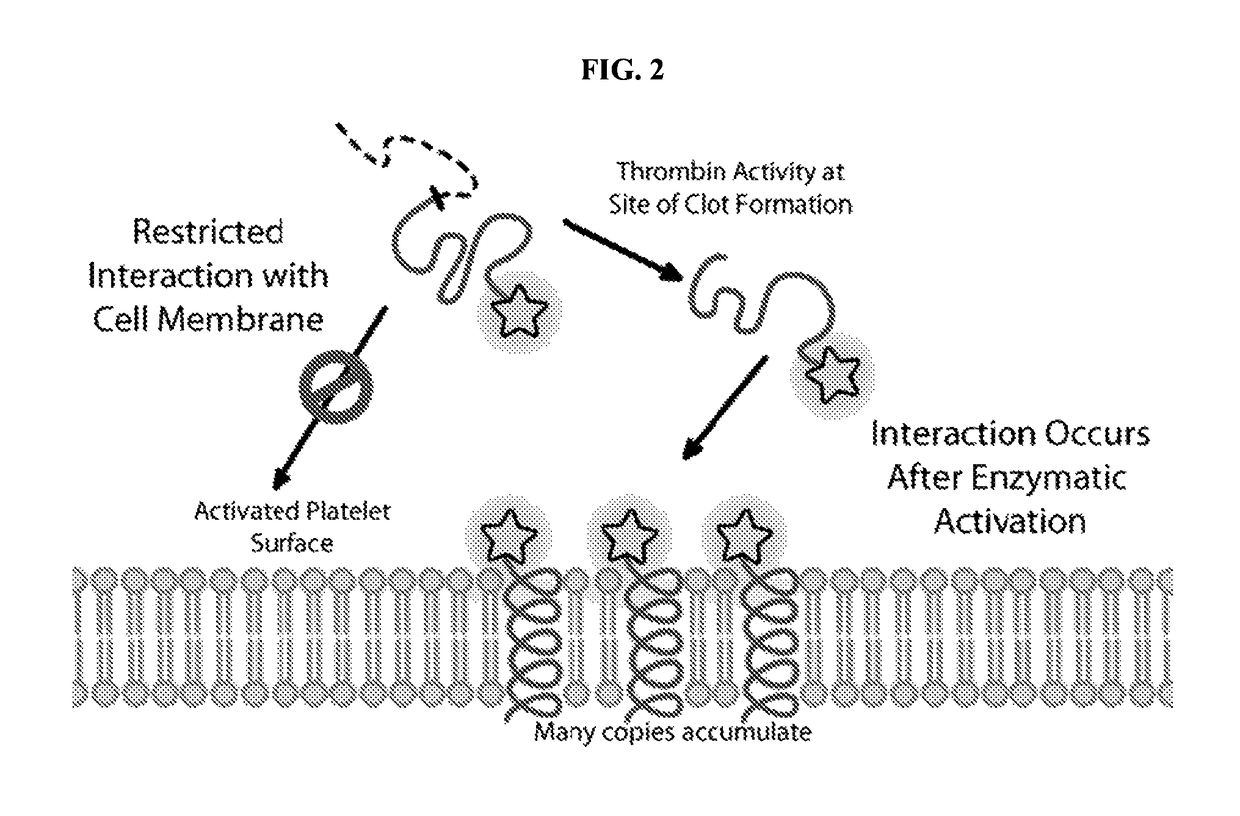Activatable membrane-interacting peptides and methods of use
a technology of activated membrane and peptide, which is applied in the direction of peptides, cell culture active agents, fusion with protease sites, etc., can solve the problems of coronary heart disease, cellular damage, and difficulty in detecting with sufficient sensitivity and specificity, and achieves the effects of reducing the number of cellular damage, and improving the detection efficiency
- Summary
- Abstract
- Description
- Claims
- Application Information
AI Technical Summary
Benefits of technology
Problems solved by technology
Method used
Image
Examples
example 1
Promolecules Containing Temporin-L for the Detection of Blood Clots
[0269]Three or four polypeptide modules were combined to form various promolecules capable of controllable cell membrane interaction. A schematic diagram of a promolecule containing four polypeptide modules is shown in FIG. 1. The naturally-occurring sequence of Temporin-L (FVQWFSKFLGRIL (SEQ ID NO: 2)) was modified to restrict non-specific activation by other trypsin-like proteases. The modified sequence (FVQWFSKFLGKLL (SEQ ID NO: 3)) was used as portion A of the promolecule. In order to form the cleavable linker X2, the amino acid sequence PR was added to the C-terminus of portion A.
[0270]The naturally-occurring thrombin substrate PAR-1 (SFLLRNPNDKYEPFW (SEQ ID NO: 18)) was modified to reduce its positive charge and add more negative charge. The modifications resulted in the amino acid sequence SFLLQDPNDQYEPFW (SEQ ID NO: 19), which was used to form portion Z of the promolecule. The amino acid sequence of the promo...
example 2
Promolecules Containing Protonectin for the Detection of Blood Clots
[0277]Protonectin is an antimicrobial peptide that is found in the venom of the neotropical wasp Agelaia pallipes. The naturally-occurring sequence of protonectin (ILGTILGLLKGL (SEQ ID NO: 4)) was used to form portion A of a promolecule. Portion X2 was formed from amino acid residues PR, and the modified PAR-1 exosite recognition sequence as described in Example 1 (SFLLQDPNDQYEPFW (SEQ ID NO: 19)) was used to form portion Z. A lysine residue was added to the N-terminus of portion A, and Cy3 fluorescent dye was conjugated to the lysine residue. The combination of these modules resulted in a promolecule having the sequence (Cy3-K)ILGTILGLLKGLPRSFLLRNPNDKYEPFW (SEQ ID NO: 48).
[0278]The promolecule was digested with 0.1 nanomoles of thrombin, followed by analysis with reverse phase HPLC to verify digestion (FIG. 18). Digestion was approximated by the Michaelis-Menten kinetic parameters kcat / KM=8 μM−1 sec−1 and KM 200 nM...
example 3
Promolecules Containing Temporin-L for the Detection of Matriptase Activity in Cancer
[0279]Many proteases have been suggested as potential biomarkers or drug targets for breast cancer, yet they remain underutilized because of the difficulty of detecting proteolysis in vivo. Restricted interaction peptides could therefore be used to diagnose such cancers in addition to being useful as reagents to understand the biology underlying these processes (FIG. 21). Examples of proteases involved with breast cancer include prostate specific antigen, cathepsin B, stromelysin 3, matrix metalloproteinase 2, urokinase-type plasminogen activator, and matriptase, among others.
[0280]A promolecule was created whose X2 linker could be cleaved by matriptase, a multidomain membrane-bound serine protease also known as MTSP-1, commonly over-expressed in infiltrating breast carcinomas. The modified Temporin-L peptide sequence described in Example 1 (FVQWFSKFLGKLL (SEQ ID NO: 3)) was used to form portion A, ...
PUM
| Property | Measurement | Unit |
|---|---|---|
| diameter | aaaaa | aaaaa |
| molar ratio | aaaaa | aaaaa |
| distance | aaaaa | aaaaa |
Abstract
Description
Claims
Application Information
 Login to View More
Login to View More - R&D
- Intellectual Property
- Life Sciences
- Materials
- Tech Scout
- Unparalleled Data Quality
- Higher Quality Content
- 60% Fewer Hallucinations
Browse by: Latest US Patents, China's latest patents, Technical Efficacy Thesaurus, Application Domain, Technology Topic, Popular Technical Reports.
© 2025 PatSnap. All rights reserved.Legal|Privacy policy|Modern Slavery Act Transparency Statement|Sitemap|About US| Contact US: help@patsnap.com



